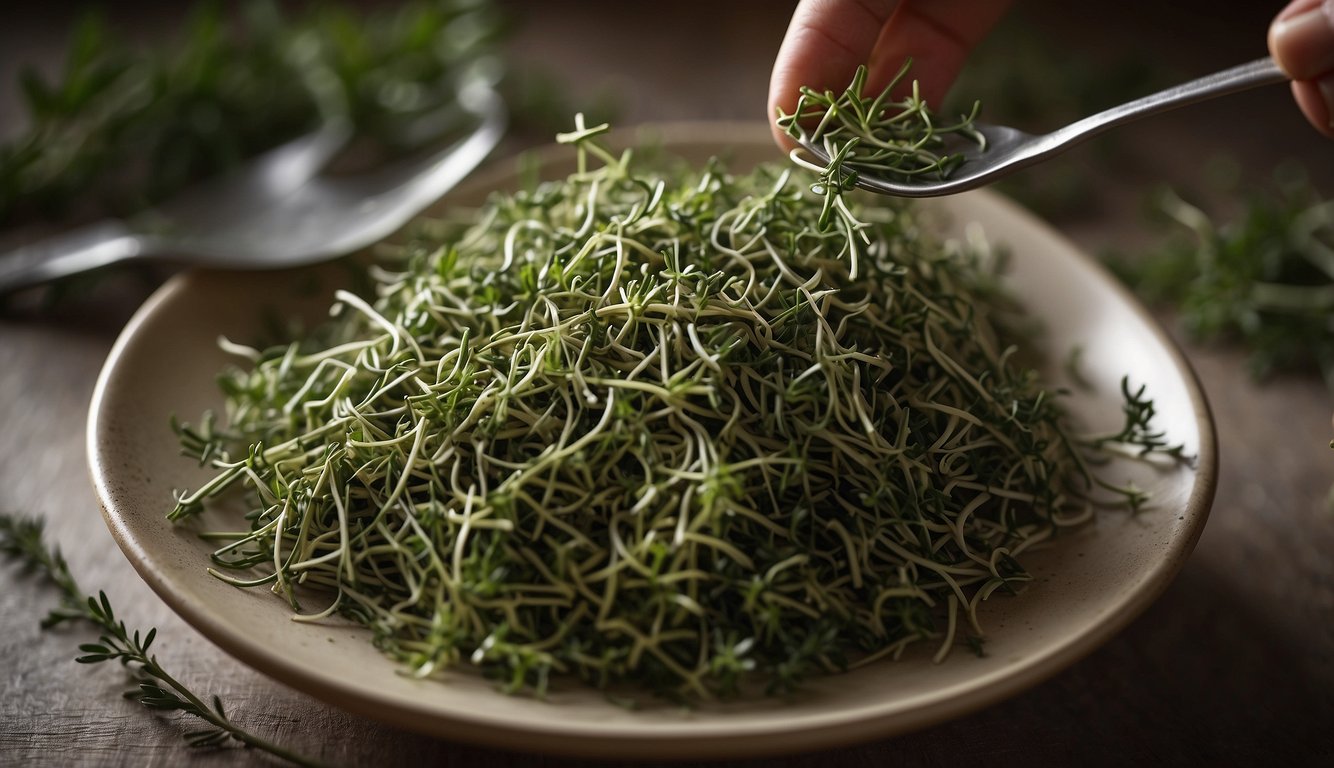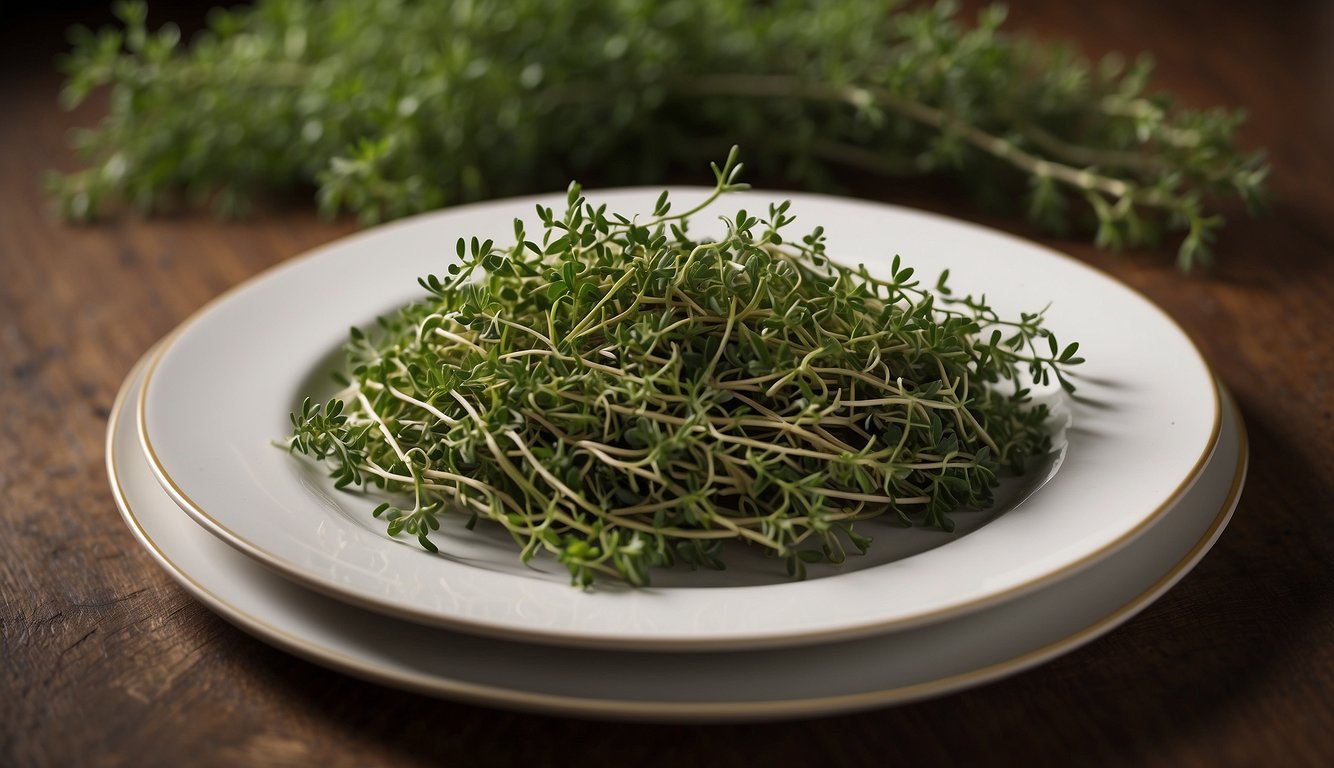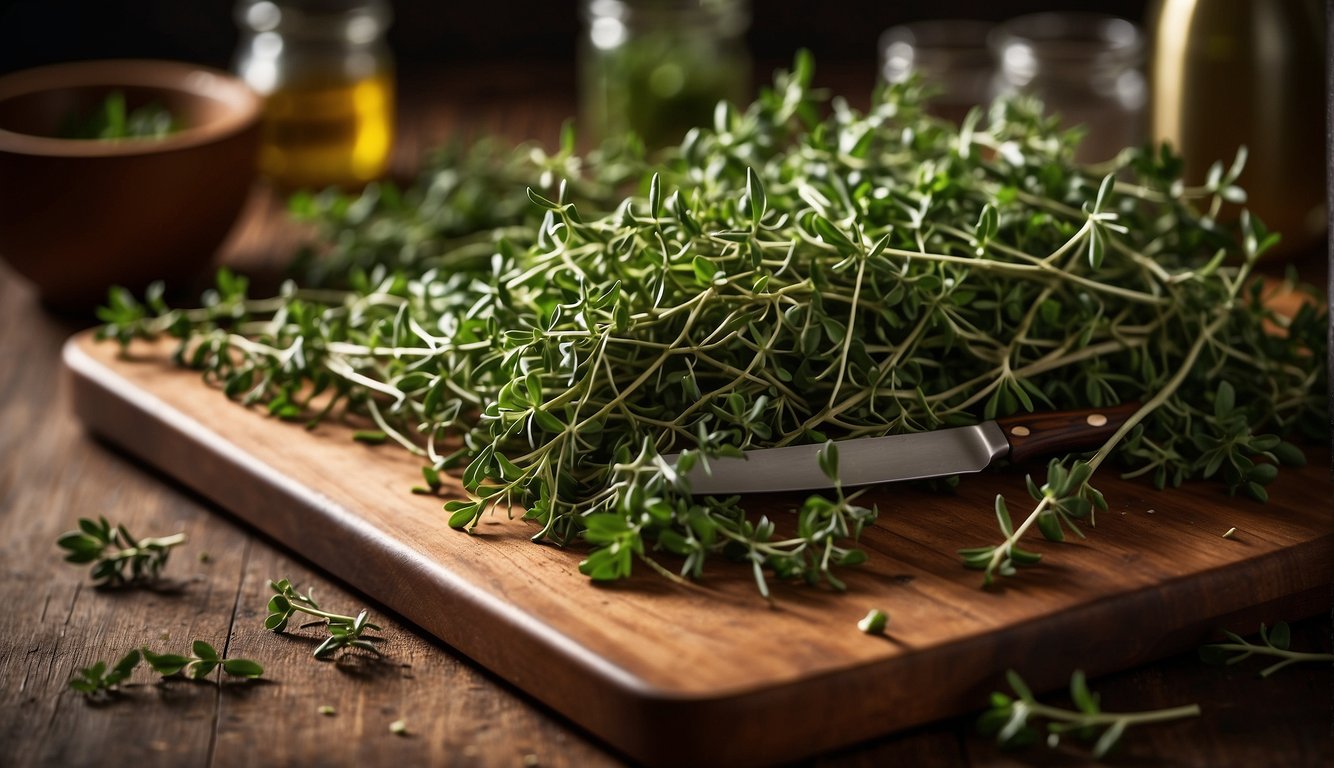TheHerbProf.com is a treasure trove of knowledge for those interested in natural healing and herbal remedies. The website is run by Paul Johnston MD. A naturopathic who has not only received extensive education in the field but also has personal experience in self-healing.
Thyme is a popular herb that is used in many dishes to add flavor and aroma. However, when preparing thyme, many people are unsure whether or not they can eat the stems. As someone who has cooked with thyme many times, I have often wondered about this myself. After doing some research and experimenting, I can confidently say that thyme stems are edible.
Thyme stems are not only edible but also add flavor to dishes. The stems are best used when they are young and tender. Once they become woody, they lose most of their flavor and become inedible. However, when the stems are young and succulent, they can be harvested, chopped, and used along with the leaves for extra flavor in your food.
If you are still unsure about whether or not to eat thyme stems, you can always experiment and see what works best for you. In my experience, using the stems along with the leaves has added an extra layer of flavor to many of my dishes. So next time you’re cooking with thyme, don’t be afraid to try using the stems as well.
Understanding Thyme

Thyme is a popular herb that is commonly used in Mediterranean cuisine. It is a member of the mint family and is native to the Mediterranean region. Thyme is known for its fragrant aroma and its ability to add flavor to a wide variety of dishes. In this section, I will provide an overview of thyme, including its different varieties and health benefits.
Thyme Varieties
There are several different varieties of thyme, but the most common is known as Common Thyme or Fresh Thyme. This variety is widely used in cooking and has a subtle, earthy flavor that pairs well with a variety of foods. Other varieties of thyme include Lemon Thyme, which has a citrusy flavor, and Caraway Thyme, which has a slightly sweet taste.
Health Benefits
In addition to its culinary uses, thyme is also known for its health benefits. Thyme is rich in antioxidants, which can help to protect the body against free radicals and reduce the risk of chronic diseases. It is also a good source of vitamins C and A, as well as iron, calcium, and manganese.
Thyme has been used for centuries to treat a variety of health conditions, including respiratory infections, digestive issues, and skin problems. It is believed to have anti-inflammatory and antimicrobial properties, which can help to boost the immune system and fight off infections.
Overall, thyme is a versatile herb that can add flavor to a wide variety of dishes, while also providing a range of health benefits. Whether you are looking to add more flavor to your meals or boost your overall health, thyme is a great choice.
Culinary Uses of Thyme

Thyme is a versatile herb that can be used in a variety of dishes to add flavor and depth. In this section, I will explore the different ways to use thyme in cooking.
Flavor Profile
Thyme has a strong, earthy flavor with hints of lemon and mint. It is a staple herb in French cuisine and pairs well with other herbs like rosemary, sage, and oregano. Thyme is also a common ingredient in Mediterranean and Middle Eastern dishes.
Cooking with Fresh vs Dried Thyme
Fresh thyme has a more subtle flavor than dried thyme and is best used in dishes that require a delicate touch. Dried thyme, on the other hand, has a more intense flavor and is better suited for heartier dishes like stews and soups. When substituting fresh for dried thyme, use three times as much fresh thyme as dried.
Pairing Thyme with Foods
Thyme pairs well with a variety of foods, including meats, vegetables, and seafood. It is a popular seasoning for lamb, adding a flavorful and aromatic touch. Thyme also works well with chicken, fish, and pasta dishes.
Thyme is a great addition to sauces, beans, and cheeses, adding depth and complexity to these dishes. It also works well in egg dishes, like omelets and frittatas, and is a great seasoning for poultry and meats.
Thyme stems are edible as long as they are young and succulent. They can be used in recipes to add flavor and texture. However, they are much tougher than the leaves and should be removed before serving.
Overall, thyme is a versatile herb that can be used in a wide variety of dishes to add flavor and depth. Whether you are cooking with fresh or dried thyme, it is a great addition to any recipe.
The Anatomy of Thyme

Thyme is a perennial herb that belongs to the mint family. It is a small plant that grows up to 15 inches tall and has tiny, fragrant leaves that are used in various cuisines. Thyme is a versatile herb that can be used fresh or dried in soups, stews, sauces, and marinades.
Stem Characteristics – Can You Eat Thyme Stems?
Thyme stems are thin and woody, with a fibrous texture that can be tough to chew. The stems are usually green when young and turn brown as they mature. Thyme stems are not as flavorful as the leaves, but they can be used to add a subtle hint of thyme to dishes.
Leaf Structure
Thyme leaves are small and oval-shaped, with a slightly fuzzy texture. The leaves are arranged in pairs along the stem and have a pungent, earthy aroma. Thyme leaves are the most flavorful part of the plant and are used in a variety of dishes.
When using thyme in cooking, it is important to remove the tough stems and only use the tender leaves. The stems can be used to flavor stocks and broths, but they are not suitable for eating raw.
Soft herbs like parsley and cilantro have a more edible texture compared to thyme, oregano, and rosemary, which are more stick-like. However, the stems of thyme, oregano, and rosemary are still edible and safe to consume.
Thyme stems are safe to eat, but they are not as palatable as the leaves. It is recommended to remove the tough stems and only use the tender leaves when cooking with thyme.
Preparing and Eating Thyme Stems

Thyme is a popular herb used in cooking for its aromatic flavor. While the leaves are the most commonly used part of the herb, the stems can also be used in cooking and are safe to eat. In this section, I will discuss when to use thyme stems, how to prepare them, and how to incorporate them in recipes.
When to Use Thyme Stems – Can You Eat Thyme Stems?
Thyme stems can be used in cooking when the recipe calls for a sprig of thyme. A sprig is a small branch or stem with leaves and is usually about 3-4 inches long. The stems should be fresh and green, and not woody. Woody stems are more or less flavorless and should not be used.
How to Prepare Thyme Stems
To prepare thyme stems, start by washing them thoroughly under cold running water. Shake off the excess water and pat them dry with a paper towel. You can then remove the leaves from the stems by holding the top of the stem with one hand and running your fingers down the stem with the other hand to strip off the leaves. Alternatively, you can chop the stems finely and use them along with the leaves.
Incorporating Stems in Recipes
Thyme stems can be used in a variety of recipes to add flavor. They can be added to soups, stews, and sauces during the cooking process. You can also use them to infuse flavor into oils, vinegar, and other liquids. Thyme stems can also be used as a garnish in salads and other dishes.
Other herbs like rosemary and oregano have woody stems and are not recommended to be used in the same way as thyme stems. On the other hand, herbs like parsley, cilantro, basil, dill, mint, sage, and marjoram have softer stems that are safe to eat and can be used in cooking.
Thyme stems are safe to eat and can be used in cooking to add flavor to dishes. They should be fresh and green, and not woody. To prepare thyme stems, wash them thoroughly and remove the leaves from the stem. Thyme stems can be used in a variety of recipes to add flavor and can also be used as a garnish.
Maximizing Usage and Reducing Waste – Can You Eat Thyme Stems?
As someone who loves to cook, I always try to make the most out of every ingredient I use. This is especially true when it comes to herbs like thyme. Thyme is a versatile herb that can be used in a variety of dishes, from savory stews to sweet desserts. But what about the stems? Can you eat thyme stems? The answer is yes! Thyme stems are edible and can be used in a variety of ways. In this section, I’ll share some tips on how to maximize usage and reduce waste when it comes to thyme.
Storing Thyme Correctly – Can You Eat Thyme Stems?
To get the most out of your thyme, it’s important to store it correctly. Fresh thyme leaves can be stored in the refrigerator for up to a week. To keep them fresh, wrap them in a damp paper towel and place them in a plastic bag. You can also freeze fresh thyme leaves by placing them in a freezer-safe container or bag. Thyme stems can also be stored in the refrigerator or freezer. Simply wrap them in a damp paper towel and place them in a plastic bag or container.
Creative Uses for Thyme Stems
Thyme stems are often discarded, but they can be used in a variety of ways. Here are some creative uses for thyme stems:
- Infuse oil: Thyme stems can be used to infuse oil. Simply heat up some oil in a pan and add the thyme stems. Let the stems simmer in the oil for a few minutes, then remove them and discard. The oil will have a subtle thyme flavor that can be used in a variety of dishes.
- Make tea: Thyme stems can be used to make tea. Simply steep the stems in hot water for a few minutes, then strain and enjoy. Thyme tea has a subtle flavor that pairs well with honey.
- Use in salads: Thyme stems can be added to salads for a subtle flavor. Simply chop up the stems and mix them in with your favorite salad greens.
- Dry and use in long cooking times: Thyme stems can also be dried and used in long cooking times. Simply tie the stems together and hang them upside down in a dry, well-ventilated area. Once the stems are dry, remove the leaves and discard the stems. The dried thyme leaves can be used in soups, stews, and other dishes that require long cooking times.
By using thyme stems in these creative ways, you can reduce waste and get the most out of your thyme.
Thyme in Herbal Teas and Infusions – Can You Eat Thyme Stems?

Brewing Thyme Tea
Thyme tea is a delicious and healthy way to enjoy the benefits of this herb. To make thyme tea, you can use fresh or dried thyme leaves and stems. Simply add a handful of thyme to a teapot or infuser, pour hot water over it, and let it steep for 5-10 minutes. You can adjust the amount of thyme and steeping time to your liking, depending on how strong you want the flavor and aroma to be.
Thyme tea has a unique flavor that is both sweet and pungent. It pairs well with other herbs like chamomile, lemon balm, and mint, and can be sweetened with honey or agave nectar for added flavor. Thyme tea is also a great way to soothe sore throats and coughs, as it has natural antibacterial and antifungal properties.
Health Benefits of Thyme Infusions – Can You Eat Thyme Stems?
Thyme is a rich source of vitamins and minerals, including vitamin C, vitamin A, iron, and calcium. Thyme infusions can help boost your immune system, improve digestion, and promote healthy skin and hair. Tea Thyme is also known to have anti-inflammatory properties, which can help reduce inflammation and pain in the body.
Thyme tea is a natural diuretic, which means it can help flush toxins from the body and reduce bloating. Thyme tea can also help regulate blood sugar levels, making it a great choice for people with diabetes or those looking to manage their blood sugar levels.
Stems Thyme can be used to make delicious and healthy herbal teas and infusions. Thyme tea has a unique flavor and aroma that pairs well with other herbs and can be sweetened with honey or agave nectar. Thyme tea is also packed with vitamins and minerals and has many health benefits, including boosting the immune system, improving digestion, and promoting healthy skin and hair.
Can You Eat Thyme Stems?
Let’s dig into the question: Can you eat thyme stems?
Well, the answer is yes! Thyme stems are edible and packed with flavor. However, they can be a bit woody, especially in mature plants.
Now, how do they help each other? Well, the leaves and stems of thyme work together in perfect harmony. The stems provide support and transport nutrients, while the leaves perform photosynthesis and produce that wonderful thyme flavor we all love!
Remember, folks, every part of the plant has its purpose. So, let’s keep exploring, keep learning, and keep appreciating the wonders of nature!
For more herbal wisdom, don’t forget to visit my homepage at theherbprof.com. Keep those green thumbs up!
References – Can You Eat Thyme Stems?
Little Herb Encyclopedia, by Jack Ritchason; N.D., Woodland Publishing Incorporated, 1995
The Ultimate Healing System, Course Manual, Copyright 1985, Don Lepore
Planetary Herbology, Michael Tierra, C.A., N.D., Lotus Press, 1988
Handbook of Medicinal Herbs, by James A. Duke, Pub. CRP Second Edition 2007
The Complete Medicinal Herbal, by Penelope Ody, Published by Dorling Kindersley
Check the Following Articles!
Round Green Vegetable with Leaves: An Overview
How To Get Grass Clippings Out Of Mulch?
Organic Rooting Hormone: Boosting Plant Growth Naturally
Frequently Asked Questions – Can You Eat Thyme Stems?

Is it safe to consume thyme stems along with the leaves?
Yes, it is safe to consume thyme stems along with the leaves. Thyme stems are edible and can be used in cooking. They are not poisonous, and in fact, they can add a subtle flavor to your dishes.
Are there any toxic parts of the thyme plant to be aware of?
No, there are no toxic parts of the thyme plant to be aware of. Thyme is generally safe to consume, and there are no known health risks associated with eating it.
Can thyme flowers be eaten in the same way as the leaves?
Yes, thyme flowers can be eaten in the same way as the leaves. They have a similar flavor and can be used to add a decorative touch to your dishes.
Is it necessary to strip thyme leaves off the stem before using?
It is not necessary to strip thyme leaves off the stem before using. The stems are edible and can be used in cooking, but they can be tough and woody. If you prefer a smoother texture, you can remove the leaves from the stem before using.
Can raw thyme be eaten without cooking?
Raw thyme can be eaten without cooking, but it is not commonly consumed in this way. Thyme is typically used as a seasoning in cooked dishes, and the heat from cooking helps to release its flavor.
Are there any varieties of thyme that should not be consumed?
No, there are no varieties of thyme that should not be consumed. All varieties of thyme are safe to eat, and they can be used in a variety of dishes. However, some varieties may have a stronger or milder flavor than others, so you may want to experiment to find the one that best suits your taste.


